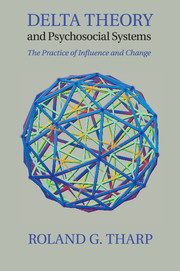Book contents
- Frontmatter
- Contents
- Figures
- Preface
- Acknowledgments
- Section One The Theory of Influence and Change
- 1 Introduction and Overview
- 2 Psychosocial Systems and the Exercise of Influence
- 3 The Zone of Proximal Development, Activity, and Semiotics
- 4 The Means of Influence
- 5 The Organization of Activity
- 6 Unifying the Study of Culture and Psychology
- Section Two The Practice of Influence and Change
- Appendix Criteria, Standards, and Guidelines Necessary for a Unified, Universal Theory
- References
- Index
5 - The Organization of Activity
Published online by Cambridge University Press: 05 December 2011
- Frontmatter
- Contents
- Figures
- Preface
- Acknowledgments
- Section One The Theory of Influence and Change
- 1 Introduction and Overview
- 2 Psychosocial Systems and the Exercise of Influence
- 3 The Zone of Proximal Development, Activity, and Semiotics
- 4 The Means of Influence
- 5 The Organization of Activity
- 6 Unifying the Study of Culture and Psychology
- Section Two The Practice of Influence and Change
- Appendix Criteria, Standards, and Guidelines Necessary for a Unified, Universal Theory
- References
- Index
Summary
Psychosocial systems in their phases – alpha, beta, or delta – have been discussed from several perspectives. In Chapter 3, they were seen as functioning in cycles of psychosocial systems. In Chapter 2, psychosocial systems were related to social network theory, and in that instance the dynamic aspects of Delta Theory were offered as an explanation for data collected from a social network perspective. In both previous instances, I proposed that the appreciation of the dynamics of psychosocial systems can be aided by considering the circular flow of four processes: propinquity (the degree of access of members to one another); joint activity (doing things together and talking about them); intersubjectivity, (coming to experience, interpret, and value the world in like ways); and affinity (feelings of preference and enjoyment for the company of other members). In the circular dynamic, the greater the degree of one of the four processes, the greater the likelihood of an increase in the degree of the next, in the order just listed.
Each of these processes is the subject of intense study in social sciences and philosophy, and each plays its own part in influence and change. It must never be forgotten, however, that the engine of this dynamism is joint activity, and that indeed the core enterprise of intentional influence and change may best be understood as the organization of activity within psychosocial units. Certainly the proximal determinant of influence for change is proffered and accepted means of influence, but this does not occur in a vacuum; it occurs during and as a part of activity engaged in together by influencer and Subject. The proximal source of the influence may be the master organizer, the Agent, but typically it is not; rather, the most effective influence is often by other members of the psychosocial unit, through whose mediation Agent brings means of influence to bear on Subject. This conceptual tangle can be simplified in this example: I will get James to help you. It is a simple idea, but it may be a challenge to Agent’s organizational ability to secure James’s agreement as to time, place, and circumstance in which influence – the assisted performance within Subject’s zone of proximal development – will bring forth the fruit of change. Even when there is only Agent and Subject, the smallest and simplest change-directed psychosocial unit (wherein Agent assists John), joint activities must be planned and organized. Choices made by Agent in the organization of activity are the most consequential for the outcome of intentional influence.
- Type
- Chapter
- Information
- Delta Theory and Psychosocial SystemsThe Practice of Influence and Change, pp. 54 - 58Publisher: Cambridge University PressPrint publication year: 2011



